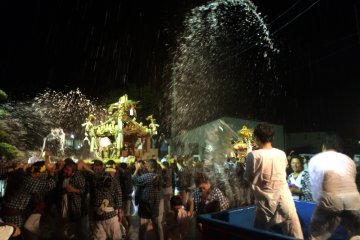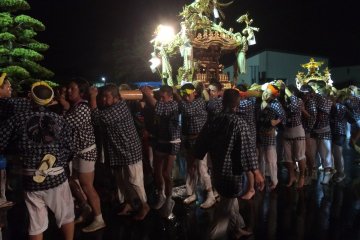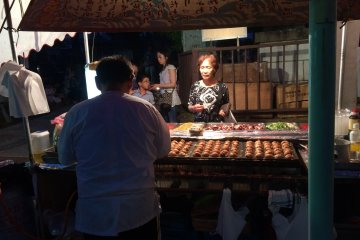It's said there's a festival every day somewhere in Japan. Each year, between 100,000 to 300,000 festivals or "matsuri" burst across the country; some new, some over 1000 years old; from neighbourhood street parties to events seen by millions. July and August is fireworks season when matsuri blaze brightest.
Much of Japan battles humid heat through summer. Armed with battery-run or bamboo fans and wearable ice-packs, punters party in defiance. Follow the music, lanterns and food stall aromas to a photographers' playground. Children catching goldfish with paper scoops. Shaved ice splashed with syrups bold as crayons. The frenzied flipping of yakisoba noodles.
People flaunt traditional cotton yukata robes. Men are austere in blue or grey but women are dazzling, taking tiny steps swaddled in vibrant prints, hair styled upwards with decorative pins. Join in, don a yukata, but careful guzzling that beer – the wrapped cloth makes bathroom visits a logistical challenge.
From writing wishes on paper to hang from bamboo poles (Tanabata festival) to dancing in straw hats to call ancestral ghosts (Awa Odori), customs vary across regions. The thunderclap of taiko drums loud enough to split the sky and the trill of flutes that mimics the cicadas' chorus are the soundtrack of summer.
History of Japanese "matsuri"
Matsuri come from ancient times when the Japanese were in awe of nature and spirits. Rituals grew to appease angry deities and ward off disasters like epidemics, typhoons and crop pests. Today, sweating men still parade elaborate portable shrines on wheels or shoulders, jerking to wake the sleeping gods inside. Once pampered with human hospitality, the divine are escorted back to their realm.
Culture thrives in the shrines' intricate carvings and sumptuous fabrics. Matsuri nurtures Japanese art and craft. Massive carnival floats can take a year of preparation. Every locality has a rite devoted to rice growing. The songs, steps and masks from old village harvest dances evolved into noh theatre.
Religious faith has weakened and the trend for larger festivals promoting tourism and entertainment grows. But the sacred and spectacle remain intertwined. Japan is a place where a fumigation company erects a tomb for white ants. Used sewing needles are honoured and laid upon soft tofu beds. Kami are the spirits that live in everything, natural and man-made – trees, rocks, teapots, calligraphy brushes...
Summer festivals blend Shinto, Buddhism and modernity in a salty, simmering soup. Cities are concrete saunas where asphalt releases warmth into the night, young and old mingle and inhibitions and social hierarchies melt away. There's so much to capture and if you're lucky, you might even glimpse a ghost or demon coming out to play.
Featured Festivals
- Sumida River Festival
- Zama Mikoshi Festival
- Saitama Summer Festivals
- Tohoku Summer Festivals
- Ebisu's Bon Odori
- Tenpin Festival
- Terasaka Rice Paddy Festival
- Noto's Kiriko Festivals
- Takahashi City Summer Festival
- Mori no Kuni Summer Festival
- Hiranosato Summer Festival
- Summer Festival in Honmoku Yokohama
- Beppu Summer Fireworks
- Kutchan Jagamatsuri
- Morito no Hama bon Dance Festival
- Kyoto's Gion Matsuri
- Nagaoka Festival and Fireworks
- Tsushima Tenno Matsuri
- The Mitsuhama Fireworks Festival
- Hanyu Natsu Matsuri
- Nagoya Castle Summer Festival
- Sanja Matsuri
On Social Media
Tag JapanTravel with your JP festival photos/videos and get reposted!
Insta: @JapanTravelcom FB: @JapanTravel Twitter: @japantravelcom
Sources:
Whelan, C., Kansai Cool, Tuttle Publishing, 2014
Festivals, Begin Japanology, (documentary), NHK (Japan Broadcasting Corporation), 2009
Festivals, Japanology Plus, (documentary), NHK (Japan Broadcasting Corporation), 2014










